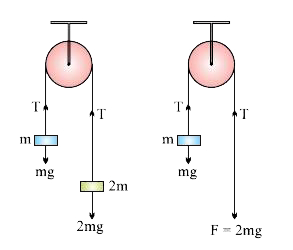The pulley arrangements shown in figure are identical, the mass of the rope being negligible. In case I the mass m is lifted by attaching a mass 2m to the other end of rope with a constant downward force F=2mg, where g is acceleration due to gravity The acceleration of mass m in case I is
 .
.
Zero
More than that in case (b)
Less than that in case (b)
Equal to that is case (b)
The correct Answer is:C
In case (a)
T−mg=mAa …(i)
2mg−T=2mAa …(ii)
Add (i) & (ii)
Aa=g/3
In case (b)
Tension in string Tb=2mg
(∵ Tension in uniform at every points in ideal string)
⇒ Ab=2mgm=2g⇒ab>Aa
Topper's Solved these Questions
- LAW OF MOTIONBOOK - NARAYNACHAPTER - LAW OF MOTIONEXERCISE - EXERCISE - III
20 Videos
- KINETIC THEORY OF GASESBOOK - NARAYNACHAPTER - KINETIC THEORY OF GASESEXERCISE - LEVEL-III(C.W)
52 Videos
- MATHEMATICAL REVIEW & PHYSICAL WORLDBOOK - NARAYNACHAPTER - MATHEMATICAL REVIEW & PHYSICAL WORLDEXERCISE - C.U.Q
13 Videos
Similar Questions
The pulley arrangement of fig. are identical. The mass of the rope is negligible. In (a) mass m is lifted up by attaching a mass (2 m) to the other end of the rope. In (b), m is lifted up by pulling the other end of the rope with a constant downward force F =2 mg. In which case, the acceleration of m is more ?

View SolutionThe pulley arrangements of Figs. (a) and (b) are identical. The mass of the rope is negligible. In (a) the mass m is lifted up by attaching a mass 2m to the other end of the rope. In (b), m is lifted up by pulling the other end of the rope with a constant downward force F=2mg. The acceleration of m is the same in both cases

View Solution
Knowledge Check
Figure shown two pulley arrangements for lifting a mass m . In case-1, the mass is lifting by attaching a mass 2m while in case-2 the mass is lifted by pulling the other end with a downward force F=2mg . If aa and ab are the accelerations of the two masses then (Assume string is massless and pulley is ideal).
 Aaa=abBaa=ab2Caa=ab3Daa=2ab
Aaa=abBaa=ab2Caa=ab3Daa=2abIn fig mass m is lifted up by attaching a mass 2m to the other end of the string while in fig
(b) m is lifted by pulling the other end of the string with a constant force F=2mg then:
 Aacceleration of m in the two situations is same and non - zeroBacceleration of m in situation
Aacceleration of m in the two situations is same and non - zeroBacceleration of m in situation
(a) is more than that of in situation(b)Cacceleration of m in situation
(a) is less than that of in situation
(b)Dacceleration of m in the two situations is same and equals to zeroIn the shown mass pulley system, pulleys and string are massless. The one end of the string is pulled by the force F = mg. The acceleration of the block will be :
 Ag/2B0CgD3g
Ag/2B0CgD3g
The pulley arrangements of fig (a) and (b) are identical. The mass of the rope is negligible. In (a) the mass m is lifted up by attaching a mass 2 m to the other end of the rope. In (b) m is lifted up by pulling the other end of the rope with a constant downward force F = 2 mg. Which of the following is correct?

View SolutionThe pulley arrangement in Fig are identical .The mass of the rope is negligble in figure the mass m is lifted up by atteched a mass 2m to the other end of the rope . In (b), m is lifed up by pulley the other end of the rope with a constant in both cases

View SolutionTwo point masses, each of mass 'm' are connected to the end of spring. If force F is applied on one of the mass, then find the acceleration of this mass if the acceleration of other mass is a ?

View SolutionTwo masses m and m' are tied with a thread passing over a pulley, m' is on a frictionless horizontal surface and m is hanging freely. If acceleration due to gravity is g, the acceleration of m' in this arrangment will be :
View SolutionIn the fig. given masses m and m' are tied with a tread passing over a pulley, m' is on a frictionless horizontal surface. If acceleration due to gravity is g, the acceleration of m' in this arrangement will be:-

View Solution
